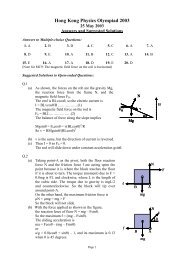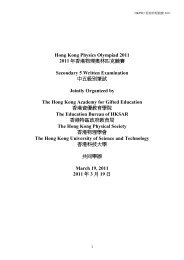Lorentz Force
Lorentz Force
Lorentz Force
You also want an ePaper? Increase the reach of your titles
YUMPU automatically turns print PDFs into web optimized ePapers that Google loves.
<strong>Lorentz</strong> <strong>Force</strong>Name: ___________________Student No: _______________Partner: __________________Session: __________________Date: ____________________Physics 121Fundamentals of PhysicsDepartment of PhysicsLast revised: Oct 2007
1. EQUIPMENT NEEDED• Electronic Balance• Dual Channel Power Supply• Multimeter (×2)• Switch Box• Transparent Shielding Box• Electromagnet with Coil and Core• Conducting Wire Segment (×4)<strong>Lorentz</strong> <strong>Force</strong>(Current Balance)2. INTRODUCTIONA charge q moving at velocity v in a magnetic field B experiences the <strong>Lorentz</strong> force perpendicular tothe plane defined by v and BF = q v × BWhen the charge is confined in a conducting wire, the force felt by the moving electrons istransferred to the wire and therefore the wire experiences the force. The force on one electron (withcharge e) travelling in a wire isf = e v d × Bwhere the drift velocity v d is related to the current density j as v d = j/ne (n is the conduction electrondensity). Substitution yieldsf = (j/n) × BThe differential length of the wire dl contains nAdl conduction electrons where A is the crosssectionalarea. So, the total force on this segment of the wire is the sum of the forces on all of theconduction electronsdF = nAdl f = idl × Bwhere i is the current and the vector dl is directed along the length of the wire segment just as thecurrent density j is. The total force F acting on a straight segment l is found by integration to beF = i l × B3. SAFETY AND HINTS• The electromagnet coil will become HOT during the experiment. Beware of handling it.• Please handle the flexible wires of the wire segment with care, as they will be easily broken.• NEVER set the current of the circuit above the maximum current limit.- 1 -
4. PROCEDUREFIGURE 1 Experiment SetupPART I: Equipment SetupThe experiment setup is shown in the Fig. 1. The coil of the electromagnet is connected in serieswith one of the output of the dual channel power supply via a multimeter (as an ammeter) and apolarity switch. The conducting wire segment is connected via two flexible copper wires and amultimeter (as an ammeter) to another output of the dual channel power supply to form a conductorloop. The two flexible copper wires should slightly loosen, so that they do not exert any force on theconducting wire segment.FIGURE 21. Fix the coil and core on the jack and connect the electromagnet circuit. Measure and record thelength of the air gap of the electromagnet L g =_________±_________.2. Remove any loading on the pan of the electronic balance and then switch on the balance.3. Connect the conductor loop circuit with the straight conducting wire segment. Place the wiresegment on the pan of the electronic balance gently.NOTE: The flexible copper wires will be easily broken, please handle them with care.- 2 -
4. Fix the crocodile clips in the conductor loop circuit, so that the flexible copper wires are slightlyloose.5. Position the electromagnet, so that the conducting wire segment is inside the air gap of theelectromagnet and has no contact with the electromagnet. In order to obtain a uniform field tothe wire, ensure that the wire segment is as close to the center of the air gap as possible.6. Cover the electronic balance with the transparent shielding box.7. Set both output of the dual channel power supply to the constant current mode (the C.C. indicator[red] should light):a) Turn the current control knob to its minimum value (fully anticlockwise).b) Turn the voltage control knob to its maximum value (fully clockwise).c) The current can then be adjusted by turning the current control knob.NOTE: The maximum current for both electromagnet and conductor loop circuit is 1.0A.8. Press the “ON/TARE” button to zero the reading of the electronic balance.9. Demagnetise the electromagnet with the following steps:a) Set the electromagnet current to about 1.0A.b) Toggle the polarity switch quickly while slowly reducing the current to zero.10. With NO current flow through the electromagnet coil (that is, no magnetic field applied to thewire segment), measure and record the reading of the electronic balance with and without currentflowing through the wire segment.Reading of the electronic balance (g)Without current ±With current (0.5A) ±11. With NO current flow through the wire segment, record the reading of the electronic balancewith and without current flowing through the electromagnet.Reading of the electronic balance (g)Without current ±With current (0.5A) ±TA signature: ________________________________PART II: Magnetic Field Dependence1. Demagnetise the electromagnet. (As in PART I, step 9)2. Set the current of the electromagnet to 0.1A by slowly turning the current control knob and makesure that no overshoot occurs.NOTE: If overshoot occurs, demagnetise the electromagnet again.3. Press the “ON/TARE” button to zero the reading of the electronic balance.- 3 -
4. Set the current of the conductor loop to 0.5A.5. Record the reading of the electronic balance and calculate the corresponding <strong>Lorentz</strong> force F inTable 1.6. Increase the electromagnet current up to 1A in steps of 0.1A and record the reading of theelectronic balance.7. Return the current of the conductor loop to zero.8. Reverse the polarity of the electromagnet current and repeat steps 1-6.TABLE 1 Data for Magnetic Field DependenceElectromagnet current (A)0.10.20.30.40.50.60.70.80.91.0-0.1-0.2-0.3-0.4-0.5-0.6-0.7-0.8-0.9-1.0Electronic Balance Reading W (g)<strong>Lorentz</strong> <strong>Force</strong> F (N)= W/1000 * 9.8Current in the conductor loop I loop = _________±_________.Uncertainty in the electromagnet current, ΔI em = ______________.Uncertainty in the balance reading, ΔW = _____________.TA signature: ________________________________PART III: Current Dependence1. Demagnetise the electromagnet. (As in PART I, step 9)2. Set the current of the electromagnet to 1.0A- 4 -
3. Press the “ON/TARE” button to zero the reading of the electronic balance.4. Set the current of the conductor loop to 0.1A.5. Record the reading of the electronic balance and calculate the corresponding <strong>Lorentz</strong> force F inTable 2.NOTE: Do not leave the conductor loop current higher than 0.5A for too long as the wire willbegin to heat up. Therefore, make your measurements as quick as possible.6. Increase the conductor loop current up to 1.0A in steps of 0.1A and record the electronic balancereading.7. Reverse the polarity of the conductor loop current and repeat steps 1-6.TABLE 2 Data for Current DependenceElectronic BalanceConductor loop current (A)Reading W (g)0.10.20.30.40.50.60.70.80.91.0-0.1-0.2-0.3-0.4-0.5-0.6-0.7-0.8-0.9-1.0Current in the electromagnet I em = _________±__________.Uncertainty in the loop current, ΔI loop = ______________.Uncertainty in the balance reading, ΔW = _____________.<strong>Lorentz</strong> <strong>Force</strong> F (N)TA signature: ________________________________- 5 -
PART IV: Length Dependence1. Measure and record the length of the one of the ’∩’-type wire segment L in Table 3.LFIGURE 3 ’∩’-type conducting wire segment2. Replace the straight conducting wire segment with this ’∩’-type conducting wire segment. (SeePart I, steps 3-6)3. Demagnetise the electromagnet. (As in PART I, step 9)4. Set the current of the electromagnet to 1.0A5. Press the “ON/TARE” button to zero the reading of the electronic balance.6. Set the current of the conductor loop to 0.5A.7. Record the reading of the electronic balance and calculate the corresponding <strong>Lorentz</strong> force F inTable 3.8. Reverse the polarity of the electromagnetic current and repeat steps 3-79. Reverse the polarity of the conductor loop current and repeat steps 3-8.10. Repeat the measurement with the rest of the ’∩’-type conducting wire segments.- 6 -
TABLE 3 Data for Length DependenceWireSegmentLengthL (mm)Currentloopcurrent(A)Electromagnetcurrent (A)ElectronicBalanceReading W (g)<strong>Lorentz</strong><strong>Force</strong> F (N)0.5 1.00.5 -1.0-0.5 1.0-0.5 -1.00.5 1.00.5 -1.0-0.5 1.0-0.5 -1.00.5 1.00.5 -1.0-0.5 1.0-0.5 -1.0Uncertainty in L, ΔL = _______________.Uncertainty in the loop current, ΔI loop = ______________.Uncertainty in the electromagnet current, ΔI em = ______________.Uncertainty in the balance reading, ΔW = _____________.Average<strong>Lorentz</strong><strong>Force</strong> F avg(N)Standarddeviationof F (N)TA signature: ________________________________5. RESULTS AND ANALYSISPART I: Equipment Setupa) With no current flow through the electromagnet coil, is there any force measured with currentflowing through the wire segment? If yes, would you explain that?______________________________________________________________________________________________________________________________________________________________________________________________________________________________________________________________________________________________________________________________________________________________________________________________________.b) With no current flow through the wire segment, is there any force measured with current flowingthrough the electromagnet? If yes, would you explain that?______________________________________________________________________________________________________________________________________________________________________________________________________________________________________________________________________________________________________________________________________________________________________________________________________.- 7 -
c) Why is it necessary to demagnetise the electromagnet?______________________________________________________________________________________________________________________________________________________________________________________________________________________________________________________________________________________________________________________________________________________________________________________________________.PART II: Magnetic Field Dependencea) Plot the <strong>Lorentz</strong> force versus the electromagnet current (which is proportional to the magneticfield). Use linear regression to fit the curve and write down the results below:Slope = _____________±_______________.y-intercept = ____________±____________.b) Is the result consistent with the theory? Explain the deviation if any.________________________________________________________________________________________________________________________________________________________________________________________________________________________________________________________________________________________________________________________.c) From the slope of the curve, determine the proportional constant k in B = kI em where B is themagnetic field and I em is the electromagnet current. Recall that F = I LB = I LkI , thusk=slope/I loop L andΔkk=⎛ Δ⎜⎝slopeslope2⎞⎟⎠⎛ ΔI+ ⎜⎝ Ilooploop⎞⎟⎠22⎛ ΔL⎞+ ⎜ ⎟⎝ L ⎠looploopemk = _____________±_______________.PART III: Current Dependencea) Plot the <strong>Lorentz</strong> force versus the conductor loop current. Use linear regression to fit the curveand write down the results below:Slope = _____________±_______________.y-intercept = ____________±____________.b) Is the result consistent with the theory? Explain the deviation if any.________________________________________________________________________________________________________________________________________________________________________________________________________________________________________________________________________________________________________________________.- 8 -
c) From the slope of the curve, determine the proportional constant k in B = kI em where B is themagnetic field and I em is the electromagnet current. Compare it with the one found in PART II.Now the equation becomes k=slope/I em L andΔkk=⎛ Δ⎜⎝slopeslope2⎞⎟⎠⎛ ΔI+⎜⎝ Iemem⎞⎟⎠22⎛ ΔL⎞+ ⎜ ⎟⎝ L ⎠k = _____________±_______________.________________________________________________________________________________________________________________________________________________________________________________________________________________________________________________________________________________________________________________________.PART IV: Length Dependencea) Plot the <strong>Lorentz</strong> force versus the length of the wire segment L. (Remember to include the data forL g ). Use linear regression method to fit the curve and write down the results below:Slope = ____________±______________.y-intercept = __________±____________.b) Is the result consistent with the theory? Explain the deviation if any.________________________________________________________________________________________________________________________________________________________________________________________________________________________________________________________________________________________________________________________.c) From the slope of the curve, determine the magnetic field corresponding to the electromagnetcurrent of 1.0A. Compare it with the ones found in PART II and III. The magnetic field is givenbyB = slope / I and thusloopΔB=BB = __________±__________.⎛ Δ⎜⎝slopeslope2⎞⎟⎠⎛ ΔI+ ⎜⎝ Ilooploop⎞⎟⎠2.- 9 -
















